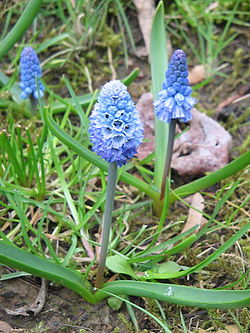| Muscari azureum | |
|---|---|
 | |
| Scientific classification | |
| Kingdom: | Plantae |
| Clade: | Tracheophytes |
| Clade: | Angiosperms |
| Clade: | Monocots |
| Order: | Asparagales |
| Family: | Asparagaceae |
| Subfamily: | Scilloideae |
| Genus: | Muscari |
| Subgenus: | Muscari subg. Pseudomuscari |
| Species: | M. azureum |
| Binomial name | |
| Muscari azureum Fenzl [1] | |
| Synonyms [1] | |
| |
Muscari azureum (syn. Pseudomuscari azureum), the azure grape hyacinth, is a species of flowering plant in the family Asparagaceae, native to Turkey. A bulbous perennial, it is grown in gardens for its spring flowers. The Latin specific epithet azureum means "bright blue", [2] a reference to its flower colour.